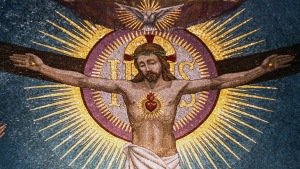One of the best places to pray is the interiority of Jesus, symbolized by his Heart. Such is the teaching of the greatest missionary of the Sacred Heart, the saint of Paray-le-Monial, Marguerite-Marie Alacoque.
Because certain spiritual experiences are difficult to understand by those who do not live them, mystics have often resorted to images to express the active presence of God in them. The spirituality of the Heart of Jesus does not escape this necessity. This is why Saint Marguerite-Marie Alacoque (1647-1690), the visionary of Paray-le-Monial, had to resort to several symbols to describe her experience of the Sacred Heart. Among these, that of the “private oratory” that the saint used in her writings.
The Heart of Jesus, an oratory where it is good to pray
When we admire a castle, it is not uncommon for our gaze to be drawn to a modest, secluded building on the edge of the inner courtyard: the private chapel. A Christian cannot fail to envy the castellans for owning a religious building, as beautiful as it is discreet, which allows them to pray when they wish, in a setting conducive to the elevation of the spirit. Because the beauty of a chapel stimulates prayer. We are carnal beings, so beautiful paintings, graceful warheads, a gothic style without overloads, have happy influences on our mind. Now, the spirituality of the Heart of Jesus offers us precisely this private chapel where we are able to pray in the best conditions: the Heart of Jesus himself!
Let us listen to what Marguerite-Marie said to her novices at the convent where she was a Visitandine nun: “When you want to pray, enter this Sacred Heart as into an oratory where you will find something to render to God what you owe him, by offering the prayer of Our Lord to make up for the defects of yours; loving God by the love of this divine Heart, adoring by his adorations, praising by his praises and operating by his operations, and willing by his wills. (Instructions to novices).
The saint assimilates the Heart of Jesus to an oratory, as to a private chapel. However, this comparison goes further than a spatial metaphor: for the Heart of Jesus is not only the place of our prayer but above all the main subject of it, the one through which and in which the believer prays, adores, praise God and want what He wants. But already, this image of the oratory helps us to understand what is going on in the spirituality of the Sacred Heart.
An oratory withdrawn to escape temptations
Just as inside a chapel, apart, the mind is led to think of divine things while abandoning those of the earth, so the Heart of Jesus encourages us to move forward in the direction of God. Here again, Marguerite-Marie uses the image of the oratory to illustrate this thought for a correspondent: “You must no longer spread your heart outwards, but cut off your affection for external things so that he strives to love his God residing in himself. Choose the Sacred Heart for your sacred oratory where you will make your prayers and orations so that they may be pleasing to God” (Letter 69).
You will enter this loving Heart as a traveler in an assured ship, whose pilot is pure love.
Elsewhere, she compares the Heart of Jesus to a fiery furnace that purifies us like gold in the crucible. And as the saint is not stingy with comparisons, in order to make the strength of the Sacred Heart better understood, she also likens it to a ship in her instructions to the novices: “You will enter this lovely Heart as a traveler in an assured ship , of which pure love is the pilot, which will guide you happily over the stormy sea of this world, preserving you from its pitfalls and tempests which are the suggestions of our enemies, the passions, our self-esteem and vanity, the bond that we have to our own will and judgment. »
In turn, the Christian becomes a chapel for Jesus!
However, this image of the private oratory is reversible because it also serves as a comparison for Saint Margaret Mary for our own heart where Jesus himself will come to lodge at his ease. In this regard, here is what she wrote, again for the novices of the convent of the Visitation: “You cannot give him stronger marks of love than to lodge him in the building that he is itself built, which is your heart, from which you must drive out these idols which you have so long adored […]. And after having chased all the enemies of the Sacred Heart from this chapel, you will line it with the purity of intention which will be to do everything to please it. Here, the metaphor of beautifying the chapel of our interiority concerns the banishment of our cherished idols. Thus, images are never absent from the writings of the mystic of Paray-le-Monial, as they are also numerous in Saint John of the Cross and Saint Thérèse of Avila.
Finally, the Heart of Jesus becomes an oratory for us as ours is for him as well. In these two images of oratories where Christ and his disciple are alternately inviting host and invited guest, the words of Jesus on the subject of the Eucharist as reciprocal inhabitation (the fact of dwelling together in other and vice versa) of the believer and his person: “He who eats my flesh and drinks my blood remains in me and I remain in him” (Jn 6, 56).

The Heart of Jesus, a private oratory that can be transported anywhere

